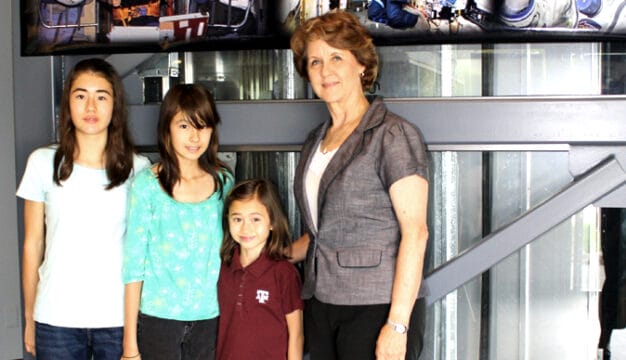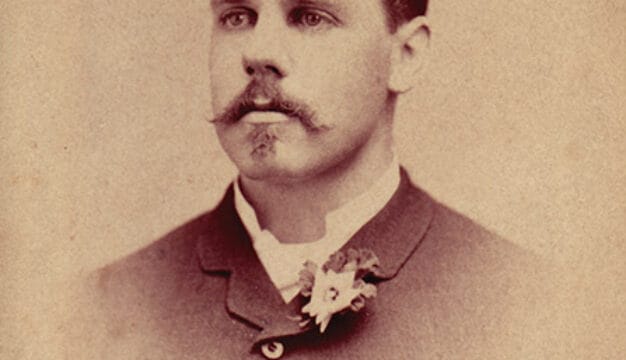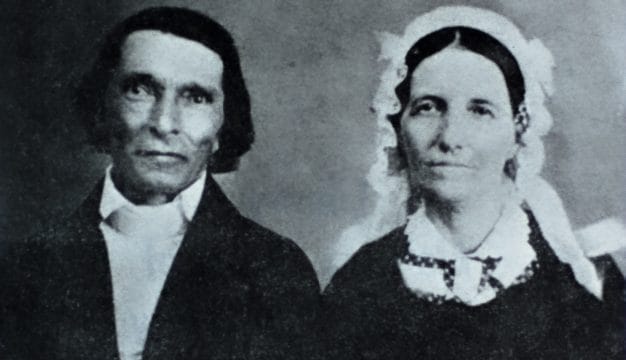James Voss
Alabamian James Shelton “Jim” Voss (1949- ) flew on five Space Shuttle missions, spent several months aboard the International Space Station (ISS), and conducted the longest spacewalk during one ISS mission to date: 8 hours and 56 minutes. Prior to his distinguished career with the National Aeronautical and Space Administration (NASA), Voss served in the U.S. Army, retiring as a colonel.
 James Voss
Voss was born on March 3, 1949, in Cordova, Walker County, and was raised by his grandparents in Opelika, Lee County. During his childhood, he read many science fiction books, especially about spaceflight. He attended Opelika High School and participated in wrestling, track and field, and football, graduating in 1967. Voss then enrolled at nearby Auburn University, in Auburn, to pursue a bachelor of science degree in aerospace engineering. He participated on the university’s wrestling team and enrolled in the Army Reserve Officer Training Corps. Upon graduation in May 1972, he received his bachelor’s degree and a commission as a second lieutenant in the U.S. Army. He deferred entry into active duty to pursue a master of science degree in aerospace engineering sciences at the University of Colorado, Boulder, graduating in 1974.
James Voss
Voss was born on March 3, 1949, in Cordova, Walker County, and was raised by his grandparents in Opelika, Lee County. During his childhood, he read many science fiction books, especially about spaceflight. He attended Opelika High School and participated in wrestling, track and field, and football, graduating in 1967. Voss then enrolled at nearby Auburn University, in Auburn, to pursue a bachelor of science degree in aerospace engineering. He participated on the university’s wrestling team and enrolled in the Army Reserve Officer Training Corps. Upon graduation in May 1972, he received his bachelor’s degree and a commission as a second lieutenant in the U.S. Army. He deferred entry into active duty to pursue a master of science degree in aerospace engineering sciences at the University of Colorado, Boulder, graduating in 1974.
After receiving his master’s degree, Voss entered active duty with the U.S. Army. He completed the Infantry Basic Course in 1974 as a Distinguished Graduate, then entered Airborne School and Ranger School, finishing as an Honor Graduate and earning the Leadership Award. He served as a platoon leader, intelligence staff officer, and company commander with the 2nd Battalion, 48th Infantry Regiment in West Germany. Voss returned to the United States in 1979 and made the Commandant’s List on completion of the Infantry Officer Advanced Course. The Army then assigned Voss to the United States Military Academy at West Point, New York, where he taught in the Department of Mechanics. Voss also participated in a NASA Summer Faculty Research Fellowship and received the William P. Clements Jr. Award for Excellence in Education as the institution’s outstanding professor.
After completing his tour at West Point, Voss attended the U.S. Naval Test Pilot School, Naval Air Station Patuxent, Maryland, and graduated in 1983 with the Outstanding Student Award. He then attended the Armed Forces Staff College in Norfolk, Virginia, after which the Army assigned him as a flight test engineer and research and development coordinator at the U.S. Army Aviation Engineering Flight Activity, Edwards Air Force Base, California, where he participated in several major flight test programs. From November 1984 to June 1987, Voss worked for NASA at the Johnson Space Center in Houston, Texas, serving as a vehicle integration test engineer for four Space Shuttle missions. He also helped investigate the explosion of the Space Shuttle Challenger, which occurred on January 28, 1986. In June 1987, NASA selected Voss as an astronaut candidate, and, after completing a one-year training and evaluation program in August 1988, he qualified as a mission specialist on Space Shuttle flights. He served as a flight crew representative on Shuttle safety, a capsule communicator providing the communications interface between ground controllers and flight crews, and as an astronaut office training officer.
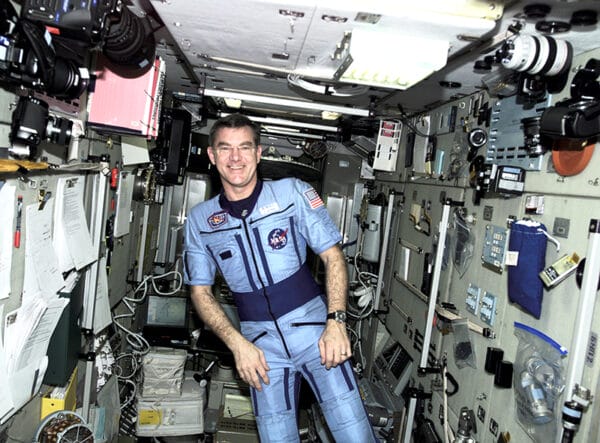 James Voss on the ISS
Between November 1991 and August 2001, Voss served as a mission specialist and payload commander for five shuttle flights, flying aboard the Atlantis (1991, 2000), Discovery (1992, 2001), and Endeavour (1995). During these missions, the Shuttle crews placed several satellites into orbit and conducted various experiments that produced significant data to support longer-duration space flights. While on the May 2000 mission aboard the Atlantis, he assisted in the construction of the ISS, which began in November 1998. Several of these flights delivered supplies and parts to the ISS to repair various systems and install new systems on the ISS. He orbited the earth 551 times in his first four Shuttle flights and spent 163 days aboard the ISS in 2001 performing spacewalks and assembly tasks and operating the station’s robotic arm.
James Voss on the ISS
Between November 1991 and August 2001, Voss served as a mission specialist and payload commander for five shuttle flights, flying aboard the Atlantis (1991, 2000), Discovery (1992, 2001), and Endeavour (1995). During these missions, the Shuttle crews placed several satellites into orbit and conducted various experiments that produced significant data to support longer-duration space flights. While on the May 2000 mission aboard the Atlantis, he assisted in the construction of the ISS, which began in November 1998. Several of these flights delivered supplies and parts to the ISS to repair various systems and install new systems on the ISS. He orbited the earth 551 times in his first four Shuttle flights and spent 163 days aboard the ISS in 2001 performing spacewalks and assembly tasks and operating the station’s robotic arm.
Overall, Voss conducted four walks in space, including the longest spacewalk to date, to test suit modifications and evaluate tools and procedures for future use on the ISS. Following his third spaceflight, Voss completed a two-year training program at the Yuri Gagarin Cosmonaut Training Center in Star City, Russia, and then served as a backup for two NASA missions to the Russian space station Mir. After his fifth and last space flight, Voss served as the deputy for flight operations in the Space Station Program Mission Integration and Operations Office, Marshall Space Flight Center, in Huntsville, Madison County. He was one of the cinematographers and featured astronauts of the first 3-D film shot in space, Space Station 3D, released in theaters in 2002 and on DVD in 2005. Voss spent a total of 201 days in space and performed more than 22 hours of spacewalks.
After retiring from NASA in 2003, Voss became the associate dean for external affairs in the Samuel Ginn College of Engineering at Auburn University. He assisted with student projects and development and taught a class in aerospace engineering on human spacecraft design.
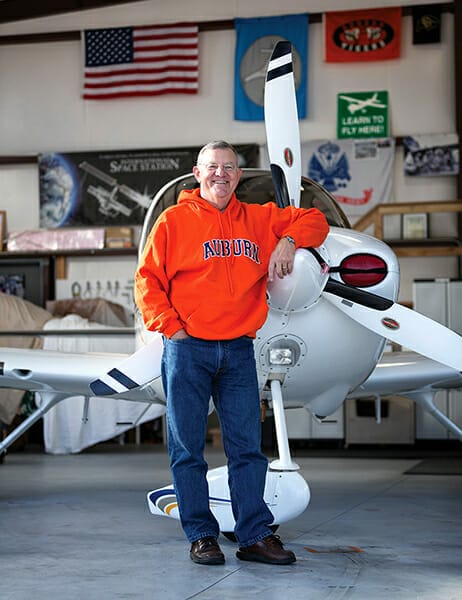 James Voss at Auburn University
Voss led a team of 12 aerospace engineering seniors and one graduate research assistant in the development of a crew seat prototype for Transformational Space Corporation (T/Space), a private aerospace company that worked with NASA to design and build space exploration vehicles. In 2005, Voss became vice president of Space Exploration Systems for T/Space.
James Voss at Auburn University
Voss led a team of 12 aerospace engineering seniors and one graduate research assistant in the development of a crew seat prototype for Transformational Space Corporation (T/Space), a private aerospace company that worked with NASA to design and build space exploration vehicles. In 2005, Voss became vice president of Space Exploration Systems for T/Space.
In 2007, Voss became the vice president of engineering at SpaceDev, another private aerospace contractor. After Sierra Nevada Corporation (SNC) acquired SpaceDev, he took over as director of advanced programs and then became vice president of Space Exploration Systems and program executive on the Dream Chaser spaceplane, a reusable crewed suborbital and orbital spacecraft. In August 2009, Voss began teaching a class on human spaceflight as a “scholar in residence” at the University of Colorado. He retired from SNC in July 2013 but continued to teach human spaceflight classes at the University of Colorado. He is married to the former Suzan Curry of Birmingham, Jefferson County, with whom he has one daughter.
Voss is a member of the NASA Advisory Council and serves on the board of directors of the National Space Biomedical Research Institute. He has received several Department of Defense and NASA awards and a number of other awards in the United States and Russia. He has been inducted into the Alabama Engineering Hall of Fame (2002) and the Alabama Aviation Hall of Fame (2011).
Further Reading
- Baker, David. NASA Space Shuttle Manual: An Insight into the Design, Construction and Operation of the NASA Space Shuttle. Minneapolis, Minn.: Zenith Press, 2011.
- Wallack, William, and George Gonzalez, eds. Celebrating 30 Years of the Space Shuttle. Washington, D.C.: National Aeronautics and Space Administration, 2012.
